Design and Development of the Railway “Maids-of-all-Work”
LOCOMOTIVES - 16
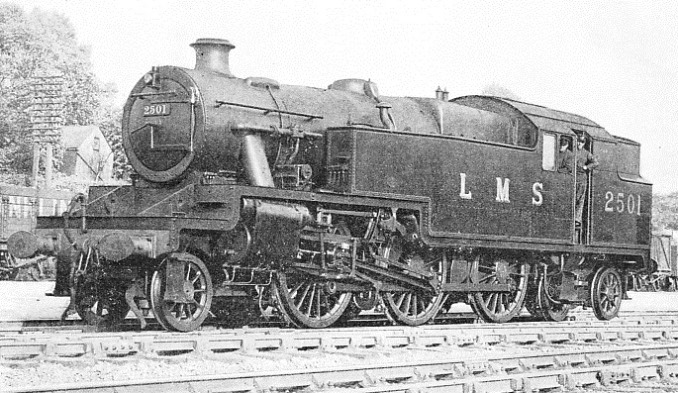
A STRIKING CONTRAST to the three tanks on the opposite page is provided by this picture. It shows one of the latest LMS tank engines, a 2-6-4 (Taper boiler 3-cylinder type), built at Derby works in 1934, for service on the Tilbury and Southend section.
THE tank locomotive, which carries its coal and water supply on the engine chassis, and requires no separate tender, has aptly been termed the railway maid-of-all-work. The type originated in this country, and its use has from early days been particularly characteristic of British locomotive practice. This tendency still obtains; of approximately 20,000 steam locomotives owned by the four British groups, nearly 8,000, or slightly under two-fifths of the total stock, are tanks, while considerably over half the total Great Western stock are in the same category. The number is lowest on the Southern, which is largely due to the great recent extension of suburban electrical working on that system.
Tank engines are of three main types - the side tank, in which the water is carried in two rectangular containers at the sides, and coal is stored in a bunker at the rear; the saddle or pannier tank, which carries its coal in the same position, but in which the water supply is kept in a single container mounted over the boiler; and the well tank, in which the water supply is kept in a tank under the coal bunker.
The well tank may represent either the sole means of storage or supplement that in the side or saddle tanks. In the side-tank design, the two tanks are connected by pipe beneath the boiler, so as to ensure that the water is maintained at the same level in both - a necessary device in order that the locomotive shall not lose its balance. Side and well tanks have been and are used for virtually every form of traffic, both passenger and goods, but the employment of the saddle tank has been confined mainly to shunting purposes; and most of the type still employed in the British Isles are kept for this particular purpose. Special advantages of the tank engines are their shorter length, as compared with tender engines, and their suitability in design for running either chimney or bunker first, so that they require no reversing at terminal stations, a feature of particular value in suburban passenger traffic work.
Although tank engines have been in use for the greater part of the railway era, their introduction came at a relatively late date in the history of the locomotive itself. The early colliery engines had tenders, and this design was followed on the first public railways both at home and abroad.
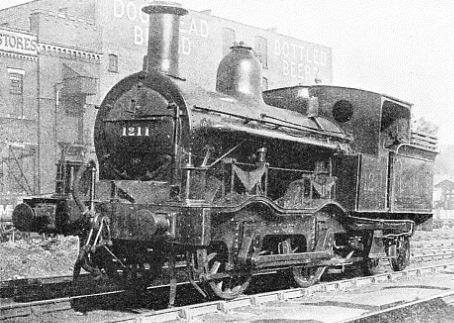
ALTHOUGH THIS TYPE OF TANK ENGINE was built more than sixty years ago for the Midland Railway, it is still in service on the LMS. This photograph shows a 0-4-4 well-tank (double frame) No. 1211, built by Beyer-Peacock & Co. in 1869.
Indeed, during the ‘thirties and the next ten years there was, in England, quite a vogue for the locomotive with a tender at either end. One reason why the tender type came first may have been that the early British locomotives used coke, while wood was largely employed in the United States, Russia, and other countries; both these forms of fuel occupy more space in relationship to their weight than coal. Furthermore, the design of even the most primitive water storage tank called for greater ingenuity than that of the early tenders, in which the water supply was kept in a barrel mounted on a simple four-wheeled truck, on the lines of the eighteenth-century chaldron wagon.
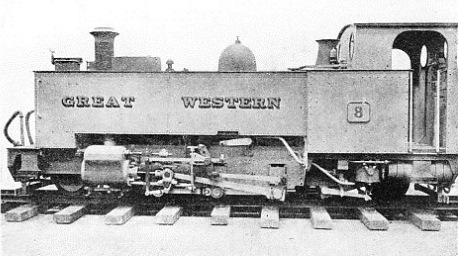
A POWERFUL NARROW-GAUGE 2-6-2 tank locomotive used on the Vale of Rheidol line, which runs from Aberystwyth to Devil’s Bridge in Wales. Note how the tanks occupy almost the whole length of the engine and the framing outside the driving wheels.
One of the earliest, if not the earliest, types of tank engine built in England was a series of Great Western broad-gauge saddle tanks, designed by Gooch, of which the first were at work in 1849. These engines were eight-wheelers (of the 4-4-0 wheel arrangement), and followed in general design the best express locomotive practice of the period, and were, incidentally, noteworthy as being early English examples of the four-coupled bogie type. The bogie, which was of spring suspension type, remained, with minor modifications, standard Great Western practice until the abolition of the broad gauge in 1892, and the wheel arrangement of these tanks was adopted by Gooch in his “Coeur de Lion” tender express class in 1855.
Many of the earlier side tanks were “singles”, a favourite wheel arrangement being the 2-2-2, which was used in the 'fifties and ‘sixties by the Eastern Counties, Edinburgh and Glasgow, Dublin and Drogheda, and London and North Western Railways, among others, the North Western employing the saddled tank. This use of the 2-2-2 wheel arrangement is of interest, since it indicates both the opening up of a wider sphere of usefulness for the tank engine in general, and is an illustration of the fact that practically every wheel arrangement adopted on tender engines has also been employed on tanks. British tank locomotives of to-day exhibit a wider range of wheel classification than tender engines.
The most celebrated of the “single” tanks, and one of the most famous types of tank engine ever built, were those first constructed in 1853 for the Bristol and Exeter Railways. These were ten-wheelers, of the double bogie type, and their 9 ft driving wheels (reduced to 8 ft 10 in, in the design of a later series) were the largest ever employed in regular service, and have, in fact, been excelled only by such “freaks” as the Great Western broad gauge “Hurricane”. The Bristol and Exeter tanks have been described as representing, perhaps, the boldest departure made up to that time from the accepted canons of locomotive design, with the possible exception of the “Cornwall”, and of Crampton’s “low centre of gravity” engines, such as the “Liverpool”. Historically, they are also of interest, because they were designed for express work, thus antedating the express tanks of a much later period, to which subsequent reference is made on this page.
No fewer than twenty-five distinct types of wheel arrangement are to be seen to-day on the tank locomotives of the British Railway groups, the total including a 2-8-8-2 belonging to the London and North Eastern, and having the quite exceptional unladen weight of 139 tons.
This is a “Garratt” locomotive, with two three-cylinder units, which was built as a banking engine for assisting coal trains over the difficult seven-mile section between Wath and Penistone (late Great Central Railway), of which two miles are on a gradient of 1 in 40. It is perhaps a debatable point whether this locomotive should not really be described as of the double tender type, but it figures in the owning company’s locomotive returns as a tank. It has also been officially described as the most powerful locomotive in the British Isles, and has a total heating surface of 3,518 sq ft. (excluding the grate area of 56.4 sq ft), a working pressure of 180 lb to the sq in, and a boiler of the remarkable external diameter of 7 ft. The cylinders are 18½ by 26 in, and the coupled wheels have a diameter of 4 ft 8 in.
THE FOLLOWING ILLUSTRATIONS are of three tank engines built by W. G. Bagnall, Ltd, at their Castle engine works, Stafford.
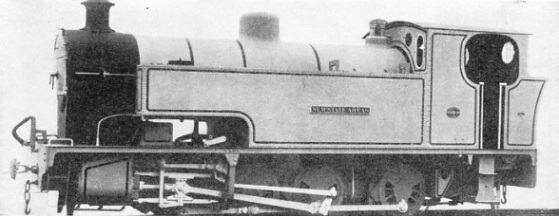
The Locomotive shown above is a 0-8-0, built for a 3 ft 6 in gauge. Its weight, in working order, is 55 tons, and it has a tractive effort of 26,169 lb. The diameter of the wheels is 3 ft 3 in, and the wheelbase is 13 ft 6 in. The capacity of the side tanks is 1,200 gallons.
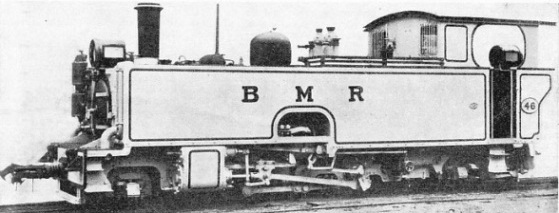
THIS TYPE IS A 2-6-2, built for a gauge of 2 ft and upwards. Its weight, in working order, is 37¼ tons, and it has a tractive effort of 12,168 lb. The diameter of the coupled wheels is 2 ft 6 in and the fixed wheelbase is 6 ft. The total wheelbase is 17 ft 10 in. The capacity of the side tanks is 760 gallons. It has a working pressure of 180 lb per sq in.
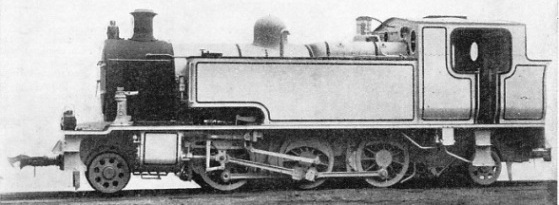
BUILT FOR A GAUGE OF 3 ft 3⅜ in, this locomotive has a tractive effort of 15,541 lb. The diameter of the coupled wheels is 3 ft 7 in, of the bogie wheels 2 ft 4½ in, and the fixed wheelbase is 10 ft. The wheelbase total is 24 ft. The capacity of the side tanks is 800 gallons.
This is, of course, an exceptional locomotive in every respect, and it is, therefore, not to be regarded as typical of British practice. The most prolific type of tank engine in Great Britain still remains the 0-6-0, of which there are roughly 3,120 in use on the four main lines, or between a sixth and a seventh of the total stock. It is worth while pointing out that despite the considerable multiplication of the largest and most powerful types, the 0-6-0 is in general still the British standard so far as the number at work is concerned. The passenger and goods engines with this wheel arrangement total 8,330, or over two-fifths of the aggregate locomotive stock, and on the Great Western they outnumber all other types put together. The 0-6-0 tank is also an early pattern; it was used by the Monmouthshire Railway in 1854, the design being remarkably similar to that of the standard London and North Western goods and mineral tender engines of a later date.
Mention should be made of a type of tank engine that, although its use in England has always been limited, is of British design, and has largely been constructed by British builders for overseas railways. This is the double tank, which differs from the articulated locomotive proper in being two engines in one that are normally coupled together, back to back. The design is usually associated with the name of Fairlie, but so long ago as 1855 Robert Stephenson had built them for Italy for main line work on the Giovi Incline between Turin and Genoa, with gradients of 1 in 29 and 1 in 36. The original Giovi type was a unit composed of two 0-4-0 saddle tanks, but the axle weight was found to be too great for the track, and the Stephenson factory subsequently built 2-4-0’s and 2-6-0’s with the same back-to-back arrangement. These engines, and the celebrated “Ghat” tank engines built in the ‘fifties for the Great Indian Peninsula Railway (the first public line opened in India), may be regarded as the forerunners of the articulated locomotive proper.
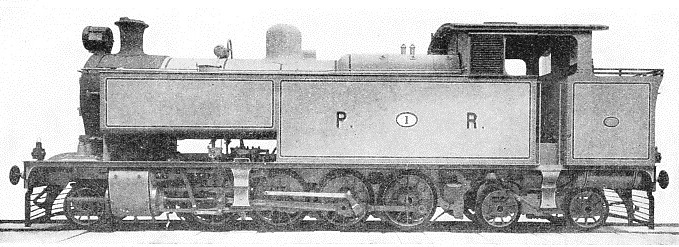
FOR SERVICE IN PALESTINE. This tank locomotive is a 2-8-4 type and was built by Kitson & Co, Ltd. It weighs 100 tons in working order, and is used between Ludd and Jerusalem.
A favourite British type of tank engine, although its popularity has declined in recent years, is the 2-4-2, or double-ender. An early model was the “White Raven”, built in 1863 for the St. Helen’s Railway, and fitted at either end with radial axle boxes, which were afterwards used for so many years on the London and North Western, where the 2-4-2 side tank was in common use. The “White Raven” was equipped with Adams’ patent spring tyres, a device consisting of a steel hoop spring between the rim and the tyre. In the following year 2-4-2 side tanks were at work on the Great Eastern.
The ‘sixties also witnessed the adoption by various railways of two types that may still be seen in use, the “front-coupled” tank and the 4-4-0. Apart from a few early 0-4-2 tank locomotives, it was the 0-4-4 wheel arrangement that became most popular for tank engines on the South Eastern and Chatham, Great Northern, Midland, London and South Western, Great Eastern, North Eastern, etc. Among the railways that at this time used the 4-4-0 were the North London, the Metropolitan, and the Metropolitan District. The type was used continuously on the two latter lines until the final withdrawal of steam traction
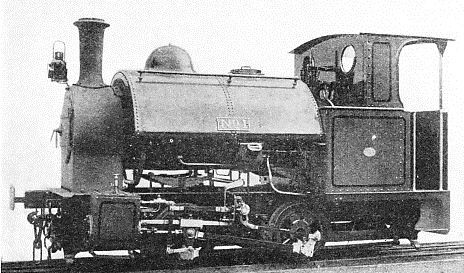
ANOTHER TANK LOCOMOTIVE built by W. G. Bagnall, Ltd. It is a 0-4-0 type and runs on a gauge of 3 ft 3 in. The diameter of the wheels is 2 ft 3½ in. The wheelbase is 4 ft 6 in. Its weight, in working order, is 12.5 tons, and it has a tractive effort of 5,257 lb. The capacity of the saddle tank is 300 gallons.
These underground locomotives deserve special mention, because the designers had to solve a novel problem, that of eliminating, or at least reducing, smoke in the tunnels, which was effected by means of a condensing apparatus. Its operation consisted in diverting the exhaust steam from the blast pipe into another pipe. From here it passed into the top of the tank. where it could be discharged on the surface of the water.
This resulted in only the upper layer of the water in the tank being heated, and the smaller pipe with an open upper end was added in consequence. The upper end was extended into the orifice of the larger pipe, while the lower end, which was also open, entered the tank. Enough steam then found its way into the smaller pipe to secure circulation of the water. As originally constructed in 1864 (only a year after the opening of the Metropolitan, which was at first worked by Great Western broad-gauge tanks and then for a short period by standard gauge London and North Western and Great Northern stock) the tanks had a capacity of 1,000 gallons, but this was increased in the later engines to 1,140.
A similar type was used by the District, 120 engines being constructed for the two companies. They had no cabs. The dome was placed unusually close to the chimney; the tank traversed the greater length of the boiler and extended along most of the footplate. The outside cylinders were slightly inclined. The use of these engines was not confined to the two Underground companies, since the North Western, South Western, and Midland had at one time a total of twenty-eight between them. A few were also made for Germany. Some of the Metropolitan and District tanks are still running in various parts of the country.
It should be mentioned that these bogie tanks were not the first to be fitted with condensing apparatus for underground working. The broad-gauge locomotives, designed by Gooch, with which the Metropolitan was inaugurated, were outside cylinder 2-4-0’s. They also had a condensing device. This was unsatisfactory, partly because the system had the defect of drawing water into the cylinders when steam was cut off, and partly because of the difficulty in keeping watertight the automatic valves fitted to the exhaust pipes for the purpose of preventing that contingency. The result was that it often became necessary to use the normal chimney exhaust.
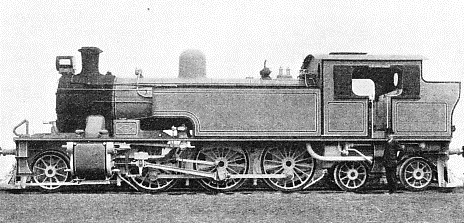
OPERATING IN CEYLON. A 2-6-4 tank locomotive built for a 5 ft 6 in gauge line by Robert Stephenson & Co.
The eight-coupled tank is sometimes regarded as of modern or relatively modern origin in this country, but the design originated so far back as 1864 on the little Vale of Neath Railway, and was two years later adopted by the Great Northern. These were the most powerful British tanks of their day, the Vale of Neath engines having a total heating surface of 1765.8 sq ft; while those of the Great Northern, which were equipped with condensing apparatus for through working on the Metropolitan, had 1,550 sq ft.
Two celebrated tank types of a later period, associated with the name of Stroudley, of the Brighton Railway, are not only known to all students of locomotive history, but survive to this day. These are, respectively, of the 0-4-2 and 0-6-0 types. The Brighton 0-6-0’s were the famous “Terriers”, probably the most powerful locomotives of their size that ever ran on any railway. Fifty were built between 1872 and 1880. The chief reason for their small dimensions was to be found in the light rails (made of iron and not steel) over the sections for which they were originally designed.
Their total weight in working order was only 24 tons 12 cwt, which was equally divided between all three axles. The heating surface amounted to the modest figure of 528 sq ft, and the tank capacity was 500 gallons. One of these engines, the “Brighton”, won a Gold Medal at the Paris Exhibition of 1878. Incidentally, this locomotive became famous; while in France it was tried over a short distance on a French train, and its performance induced the then Western of France Railway (now part of the State system) to accelerate some of its services.
The Brighton system specialized among British railways in employing tank engines for express passenger work. Until the electrification of the main line between London and Brighton, many of the fastest and heaviest passenger trains were regularly hauled by side tanks. These included the “Baltics”, or 4-6-4’s of the “Remembrance” class, which have lately been reconstructed as 4-6-0 tender engines.
Another celebrated tank of an experimental type was Holden’s 3-cylinder “Decapod”, built for the Great Eastern in 1902 as an 0-10-0 side tank in reply to the challenge of suburban electric traction. The “Decapod”, drawing a heavy train, proved its ability to accelerate from rest to thirty miles an hour in thirty seconds. It was, however, too heavy for the permanent way, and, shortly after its conversion in 1906 to an 0-8-0 tender engine, was withdrawn from service.
In their original form, these Brighton locomotives had a heating surface of 2096.7 sq ft, the weight in working order was 98½ tons and the driving wheels had the exceptional diameter - for a tank engine - of 6 ft 9 in. Twenty-one 2-6-4’s were for a time at work on the South Eastern and Chatham section of the Southern These were of the “River” class, and had 6ft driving wheels and two cylinders, save for the first of the type, the “River Frome”, which had three.
The “Rivers” were designed for working heavy suburban and other passenger trains. Only five 2-6-4 tanks, of a later design, now remain on the company’s books. Add the Southern’s “Atlantic” tanks, of which there are sixty-one, and the four 4-8-0 side tanks, built for handling traffic at the Feltham marshalling yard - where they are required to move trains of from sixty to eighty loaded wagons over the “hump” - and it will be gathered what an important part the powerful tank engine plays in the working of a modern railway.
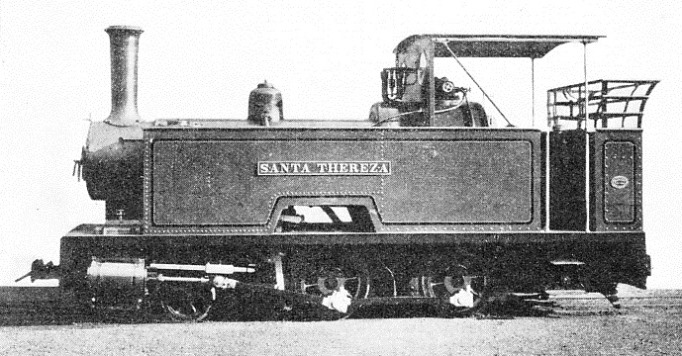
THIS TYPE OF LOCOMOTIVE is used on many sugar plantations throughout the world. It weighs 13¾ tons and has a working pressure of 150 lb per sq in. The cylinders are of 9 in-diameter and have a 14-in stroke. The coupled wheels are of 2 ft 3½ in diameter.
Since locomotive compounding has never thoroughly acclimatised itself in England, there is nothing surprising in the fact that most British tank engines have always been of the “simple” variety.
But there was a noteworthy exception to this rule during the regime of the late F. W. Webb at Crewe. Webb first experimented with compounding in 1879, when he converted a six-wheeled “single” by lining up one of the 15-in cylinders, then reducing its diameter to 9 in, and reconstructing it to work on the Mallet system. Incidentally, the Mallet engine of 1878 that Webb used as a model was a tank.
The success of the experiment led Webb in 1882 to build his first three-cylinder compound for the London and North Western, in which he adopted the principle, not copied by any other designer, of using two sets of non-coupled driving wheels. The high pressure cylinders worked on to the rear axle, while the single low-pressure cylinder, which was placed inside the frames, operated the front drivers. This design, which was much criticized and scrapped by his successors - he himself adopted the orthodox coupling rod in later types - was also used on a series of tanks. The first of these made its appearance in 1884; it was converted from one of the Metropolitan class referred to above. But Webb was never partial to the use of bogie trucks, preferring radial axles, and two of his later compound passenger side tanks had the 2-4-2 wheel arrangement, while a compound goods tank that he introduced in 1887 was of the 2-2-4-0 type. This last had originally been designed as a 2-6-0, but Webb subsequently compromised, and left the leading pair of 5 ft 2½ in wheels uncoupled. The four compound side tanks built by Webb do not appear to have given particular satisfaction, and they were scrapped between 1897 and 1901.
Surviving Engines
As mentioned above, no fewer than twenty-three different types of tank locomotive, exclusive of Garratts, are in use by the four British Railway groups.
With the exception of the four-wheeled “singles” of the 2-2-0 and 0-2-2 wheel arrangement, practically every type of locomotive in use in the earliest days still survives.
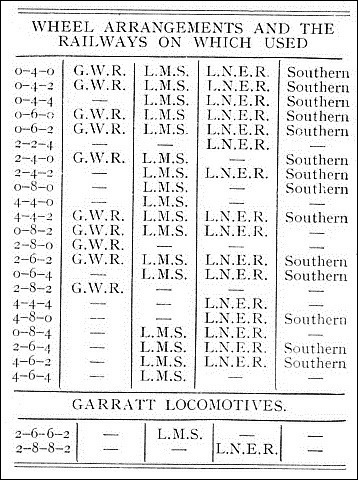 This is especially noteworthy with the 0-4-0’s, of which there are still as many as 235. Most of these are, however, rarely seen by the travelling public, since their main employment is for shunting and works purposes. Of the twenty-three types, excluding the Garratts, only six are common to all four groups. These types range from the old-fashioned four-wheelers and 0-6-0’s to such relatively modern designs as 2-6-2’s and “Atlantics”. Of the 2-4-2 “double- enders” there are still as many as 588. But this must be regarded as a disappearing type, as there is only a solitary survivor on the Southern, while the Great Western, on which the wheel arrangement was for so many years largely identified with suburban passenger traffic working, scrapped its last five in 1933.
This is especially noteworthy with the 0-4-0’s, of which there are still as many as 235. Most of these are, however, rarely seen by the travelling public, since their main employment is for shunting and works purposes. Of the twenty-three types, excluding the Garratts, only six are common to all four groups. These types range from the old-fashioned four-wheelers and 0-6-0’s to such relatively modern designs as 2-6-2’s and “Atlantics”. Of the 2-4-2 “double- enders” there are still as many as 588. But this must be regarded as a disappearing type, as there is only a solitary survivor on the Southern, while the Great Western, on which the wheel arrangement was for so many years largely identified with suburban passenger traffic working, scrapped its last five in 1933.
The 4-4-0 has nearly vanished; the London and North Eastern’s last three also went in 1933, and the London Midland and Scottish has only four left. The Southern “front-coupled” eight-wheelers still make up the respectable total of 320, or exactly a sixth of the whole locomotive stock, and two-fifths of all its tanks.
Reference has already been made to many of the individual types enumerated in the above list, but some others call for special mention. The London, Midland and Scottish “Baltics”, or 4-6-4’s, of which there are twenty, vary in dimensions. The tube heating surface ranges from 1,173 to 1,850 sq ft, the tank capacity from 2,000 to 2,400 gallons, and the coal accommodation from three to four tons. These “Baltics” also exist with four different cylinder and coupled wheel dimensions, that of the latter ranging from 5 ft 8 in to 6 ft 3 in.
Of special interest are the London, Midland and Scottish Beyer-Garratt engines, of which there are now thirty-three, all used for freight traffic. The first batch consisted of three, designed for hauling heavy coal trains between Toton and Brent, on the Midland division, and were so successful that thirty more were soon ordered from the same makers. They have two sets of outside cylinders, 18½ in by 26 in, the diameter of the coupled wheels is 5 ft 3 in, and the weight in working order is 148 tons 15 cwt. Together with the London and North Eastern Garratt, of which, however, only one has been built, they represent the limit in power attained to date on British tank engines, but their use is, of course, of a specialized nature.
It will be observed that the most powerful of tank engines used by all four groups is the 2-6-2, of which there are 473. The type is especially common on the Great Western, which possesses as many as 396. This particular type of engine was introduced on that line as far back as 1905.
British eight-coupled tanks are more specifically used for banking purposes. Five of the 0-8-2 type were built in 1908 for the Lancashire and Yorkshire, and their cylinders - 21½ in by 26 in - were at the time the largest that had been employed in this country for a “simple”. The London, Midland and Scottish 0-8-4 side tanks, of which there are thirty, is a more recent production, the type having been introduced in 1923. At one time, the Midland used an 0-10-0 type for banking purposes, but this was a tender engine, and the type no longer exists.
The distinction of being the most unusual type of tank engine ever designed belongs to the Kitson-Still locomotive, which left the makers’ works at the end of 1927, and combined a number of exceptional features.
The Kitson-Still Engine
This engine was part-steam and part-Diesel operated. This locomotive combines the flexibility of the steam engine with the economy in operation of the Diesel. Mr. Still’s remarkable engine uses steam on one side of each piston (there are eight cylinders) and the pressure of burning oil for the return stroke.
The heat produced in the Diesel end of the cylinder, which is water-jacketed, is used to generate steam for use in the opposite end, and the Diesel exhaust is also employed to heat the locomotive’s steam boiler. This boiler is heated by a special oil burner on starting, but steam is normally maintained by the waste heat of the Diesel system. The engineers have thus obtained a double-acting engine of very high efficiency.
The eight cylinders of the Kitson-Still locomotive are arranged, tandem fashion, in two sets of four, but unlike the rest of the relatively small number of tandem locomotives the cylinders were opposed so as to work on the same crankshaft. The steam ends of the cylinders faced the crankshaft, the Diesel portions being farthest from the cranks. Indirect drive was employed, the connecting rods working on to a shaft placed between the boiler (which was high-pitched) and the coupled wheels. The power was transmitted to the latter by gearing of the ratio of 1.878 to 1. The wheel arrangement was of the 2-6-2 type.
Owing to the space occupied by the cylinders and their position above the wheels, the water tank, which had a capacity of 1,000 gallons, was accommodated at the rear, beneath a fuel oil tank, with a storage space of 400 gallons. The working pressure was 180 lb to the square inch. The coupled wheels were of 5 ft diameter and the leading and trailing pair of 3 ft, and a combined exhaust was provided for both sets of cylinders. The smoke-box was extended, and the leading truck projected to an unusual extent beyond the front end of the engine.
The Kitson-Still engine has not yet been developed to the state of utilization in regular railway work. Its design is most ingenious, however, and is particularly interesting in view of the remarkable developments which have taken place in the use of the Diesel engine for railway work.
Tank engines, as a class, have given valuable service to the railways of the world and, with the weight of the water tanks and coal bunker available for adhesion, have proved capable of handling all kinds of traffic from heavy mineral trains to the fastest main-line expresses.
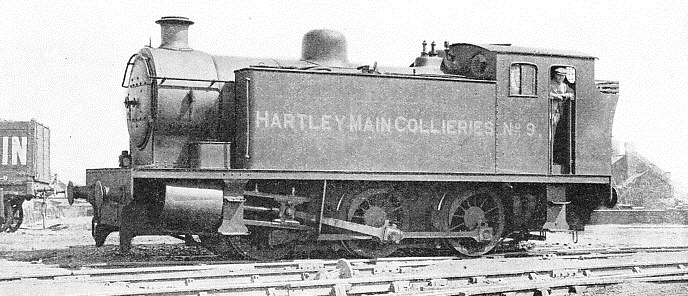
A TANK ENGINE OF THE 0-6-0 TYPE, which is used for coal haulage at the Hartley Main Collieries, near Newcastle-on-Tyne.
You can read more on “British Express Locomotives”, “A Famous Locomotive Type” and
“Mixed traffic Locomotives” on this website.













 This is especially noteworthy with the 0-
This is especially noteworthy with the 0-